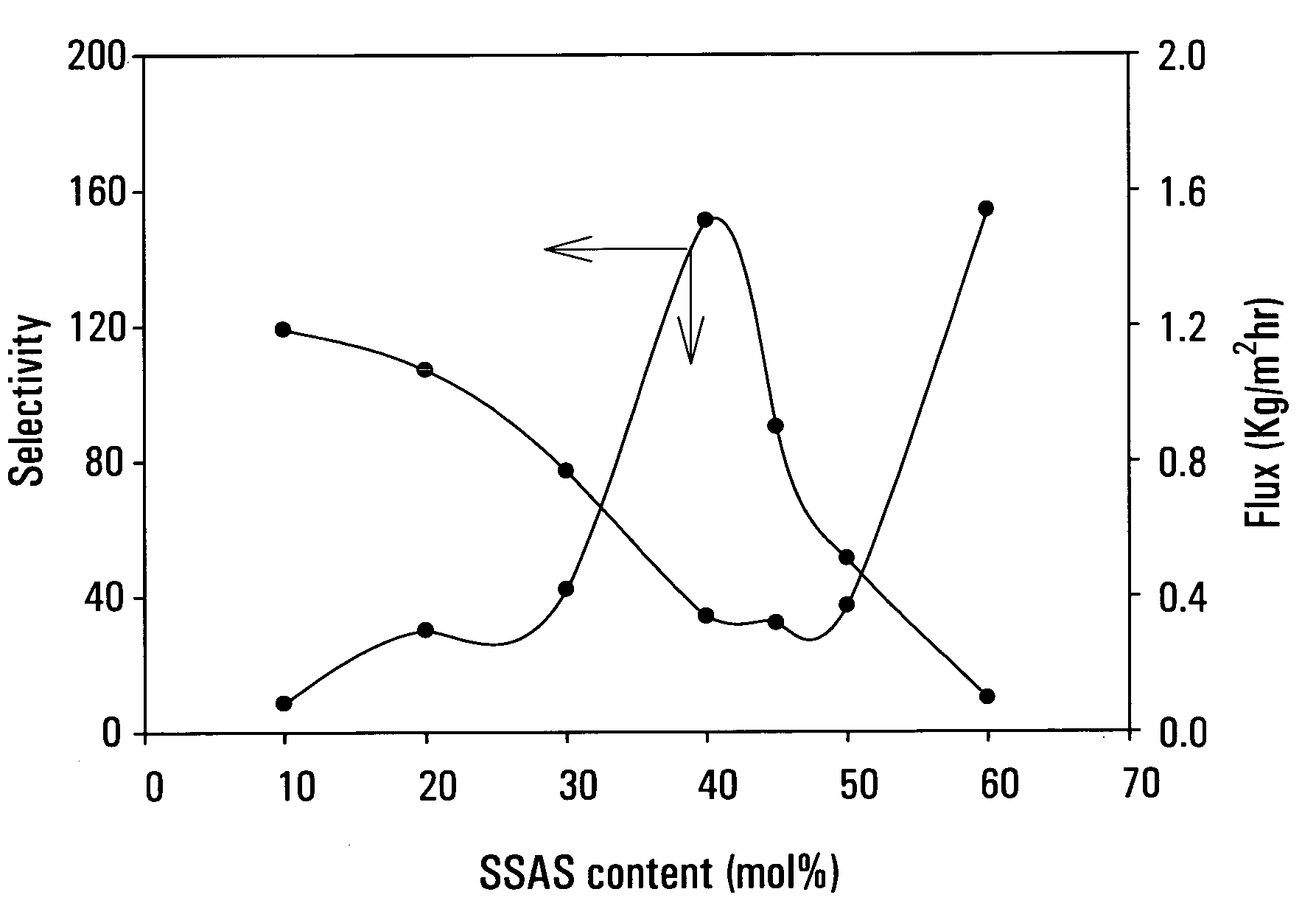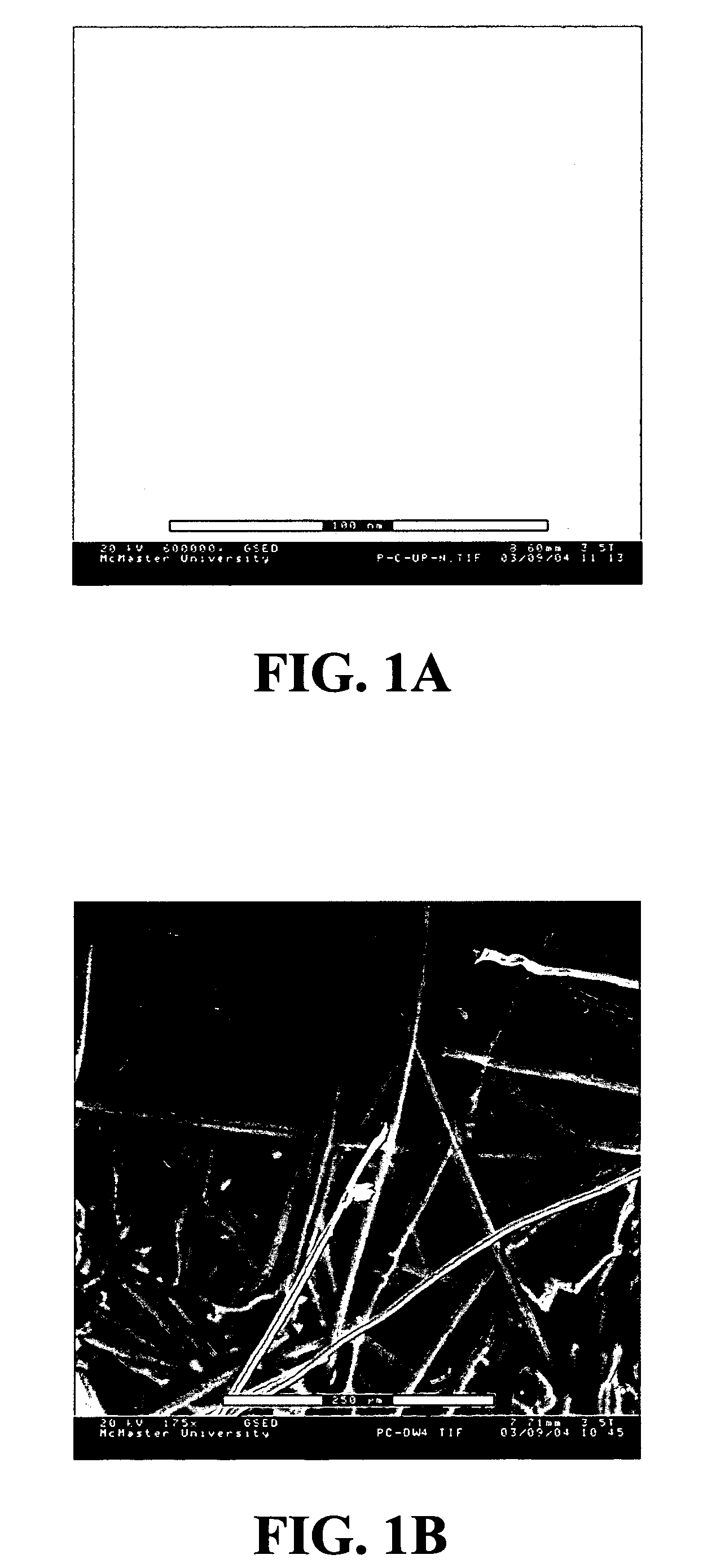Pervaporation composite membranes
a composite membrane and pervaporation technology, applied in the field of composite membranes, can solve the problems of complex removal of water, increased cost of this solvent, and production of anhydrous ethanol
- Summary
- Abstract
- Description
- Claims
- Application Information
AI Technical Summary
Benefits of technology
Problems solved by technology
Method used
Image
Examples
example 1
[0072]This example illustrates the preparation of composite membranes of the invention using either a thermal- or a photo-initiated method.
Thermally-Initiated In Situ Polymerization:
[0073]In this example, the anionic monomer used was methacrylic acid, sodium salt (MAAS), the cationic monomer was diallyldimethyl ammonium chloride (DADMAC). The mole ratio of DADMAC / MAAS was 4:1. The cross-linker used was N,N′-methylenebisacrylamide (MBAA), the amount of MBAA used was 3% based on the total molar amount of monomers. Ammonium persulfate was used as the thermal initiator, its amount was 1.0% of the total weight of monomers. Mixing the above chemicals and diluting them to 50% monomers concentration, stirring the mixture for 0.5-2 hrs till all solids are dissolved in water. After filtration to remove any undissolved solid by filter paper, the mixture was ready to prepare the membrane.
[0074]A CA microfiltration membrane with a pore size of 0.8 μm and a porosity of 72% was used as support mem...
example 2
[0079]This example illustrates the use of an asymmetric membrane as support member to prepare pervaporation membrane of this invention.
[0080]In this example, A PAN HV1,1 / T ultrafiltration asymmetric membrane was used as support member, its mean pore size is 0.0246 microns as specified by the provider. The cationic monomer was [2-(methacryloxy)ethyl]trimethylammonium chloride (MAETAC), the anionic monomer was methacrylic acid (MAA). Their mole ratio was 4:1. MBAA was used as cross-linker, its amount was 3% of the total moles of monomers. Photo initiator Irgacure 2959 was taken, its amount was 0.5% of the total weight of monomers. The concentration of the monomers in the solution was 60 wt. %. The membrane was prepared in accordance with example 1 using the photo-initiated method.
[0081]When dealing with 89.2% IPA / water at 75° C. in pervaporation test, the membrane has a flux of 2.35 Kg / m2 hr and the permeation water content is 97.0 wt. %.
example 3
[0082]This example demonstrates the effect of anion / cation mole ratio on the performance of pore-filled membranes.
[0083]A series of membranes were prepared with different anion / cation mole ratio. The anionic and cationic monomers were MAA and 3-(acrylamidopropyl)trimethylammonium chloride (APTAC), respectively. Six anion / cation mole ratio, i.e., 0:100, 20:80, 40:60, 60:40, 80:20, 100:0, were used. The total concentration of the monomers in solution was 65 wt. %. All other conditions were the same as example 1 using the photo-initiated polymerization method.
[0084]These membrane were tested with 90.9 wt. % IPA / water and the results are shown in FIG. 3. In the whole mixture range, anion / cation copolymer filled membranes have both higher flux and higher selectivity than MAA filled membranes. When the cation content in monomer solutions higher than 50 mol. %, the flux and selectivity of prepared membranes are higher than those of only anion or cation filled membranes.
PUM
| Property | Measurement | Unit |
|---|---|---|
| size | aaaaa | aaaaa |
| porosity | aaaaa | aaaaa |
| porosity | aaaaa | aaaaa |
Abstract
Description
Claims
Application Information
 Login to View More
Login to View More - R&D
- Intellectual Property
- Life Sciences
- Materials
- Tech Scout
- Unparalleled Data Quality
- Higher Quality Content
- 60% Fewer Hallucinations
Browse by: Latest US Patents, China's latest patents, Technical Efficacy Thesaurus, Application Domain, Technology Topic, Popular Technical Reports.
© 2025 PatSnap. All rights reserved.Legal|Privacy policy|Modern Slavery Act Transparency Statement|Sitemap|About US| Contact US: help@patsnap.com



